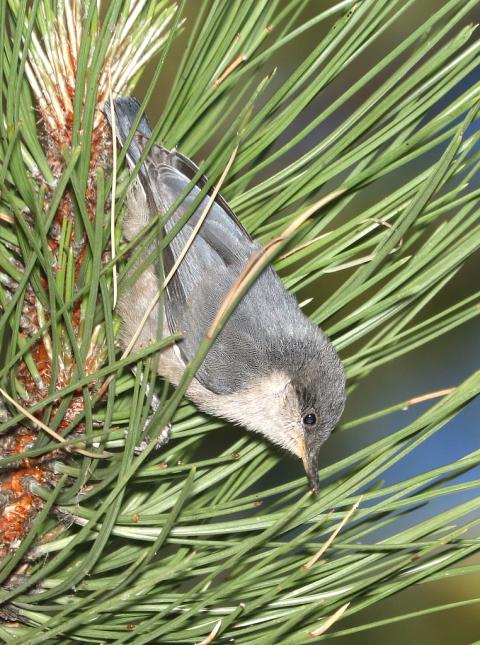Moderate
The population of pygmy nuthatch in Washington is low and the trend is unknown. This bird is a "Species of concern" because of its dependence on old ponderosa pine forests to provide suitable nesting cavities in dead and decadent trees and a year-round food source of pine seed. Certain timber management practices and fire suppression have altered the structure and species composition of ponderosa pine forests.
Description and Range
Physical description
The pygmy nuthatch is four inches long. It has a dark gray-brown cap, a white cheek and throat, a gray back, and a buff-colored belly. A light spot is on the back of the head.
Ecology and life history
The pygmy nuthatch is restricted almost completely to ponderosa pine forests at low elevation in eastern Washington, and may be rarely found in adjacent Douglas-fir forest.
Pygmy nuthatches are one of only a few cooperatively breeding songbirds in North America. During the breeding season, about a third of the pairs have up to three helpers at the nest. These helpers are usually related males, often offspring from the previous year, and help defend the nest site and raise the young. Pairs form long-term bonds and remain paired year-round.
Pygmy nuthatches are cavity nesters, meaning they nest and roost in natural cavities and woodpecker holes. Winter flocks roost together in cavities. Both members of the breeding pair dig the nest hole in a dead branch or snag of a ponderosa pine or aspen. The nest hole is lined with bark strips, plant down, moss, cocoons, fur, and feathers.
Pygmy nuthatches forage primarily on insects during the breeding season and on pine seed and insects in winter.
Geographic range
The pygmy nuthatch is an uncommon resident in northeastern counties, along the east slope of the Cascades, and in the Blue Mountains. Breeding Bird Survey data from 1966 to 2013 and from 2003 to 2013 indicate stable trends in the Great Basin province, all western USA routes combined, Washington, Oregon, California, and British Columbia. The data confidence is high for California and the western USA routes combined, while it's moderate for all other areas.
The size of Washington's breeding population is currently unknown.
For a map of range-wide distribution and conservation status of this species, check out NatureServe Explorer.
Climate vulnerability
Sensitivity to climate change
Moderate
Pygmy nuthatches likely exhibit physiological sensitivity to cold temperatures, but utilize controlled hypothermia, communal roosting, and sheltered roosting cavities to survive cold periods. Pygmy nuthatches are likely more sensitive to climate changes that affect foraging and nesting opportunities. Low- and moderate-severity, high-frequency fire helps maintain mature, open ponderosa pine habitat preferred by this species, but severe fire can destroy habitat in the short-term and inhibit ponderosa pine regeneration. Warming temperatures and xeric conditions may facilitate habitat expansion to higher elevations and into previously mesic areas, but can also lead to mortality of mature ponderosa pine individuals, affecting foraging and nesting opportunities. Warmer temperatures will likely increase insect foraging opportunities.
Exposure to climate change
Moderate
- Altered fire regimes
- Increased temperatures
Conservation
Conservation Threats and Actions Needed
- Agriculture side effects
- Threat: Forest management. Logging, fire suppression and commercial and residential development that removes or degrades mature ponderosa pine habitat.
- Action Needed: Protect existing habitat using a variety of conservation tools. Restore degraded pine forests by reducing the density of small trees and understory vegetation.
- Resource information collection needs
- Threat: Better define the range of the species.
- Action Needed: Conduct standard surveys to better define range.
- Threat: Information lacking for trends of populations.
- Action Needed: Recruit volunteers to enable inclusion of additional Breeding Bird Survey routs to increase the reliability of the data for Washington.
See the Climate vulnerability section for information about the threats posed by climate change to this species.
Resources
References
Leach, R. H. 2005. Pygmy Nuthatch (Sitta pygmaea). Pp 281-282 in T. R. Wahl, B. Tweit, and S. G. Mlodinow (eds.) Birds of Washington: Status and Distribution. Oregon State University Press, Corvallis, OR, USA. 436 pp.
